Foundation Plugin
-
Simple bolts. More detailed will only be required in detailing, which generally are separate (highly detailed) models.
-
For now I will eliminate the beveling of bolt heads and nuts, the added number of polygons is too hard to justify and the bevel doesn't really add much when your zoomed out at building scale anyways (in other words you really can't see the bevel).
There is always an option to turn the anchor bolts on or off, that is a given. Some users may want this function others may have absolutely no use for it. It will be there if you need and want it.
For now I am going to go with 1/2" and 5/8" anchor bolts, I can always add more sizes later by request. The standard sizes of anchor bolts are per a specification I pulled from Fastenal (major manufacturer of fasteners in the US). I will start with 10", 12" and 14" lengths.For the square washers I will give an option between 2"x2" and 3"x3", with the 3x3 being the more typical I would think with the latest 2012 and 2015 cycle of ICC codes. The exact dimensions of the square washers are per Simpson Strong-Tie's offering in there wood fastener manual.
The hex nuts are per the Machinery Handbook 27th Edition.
If anyone has a metric spec. for anchor bolts (L-bolts) please send it my way and I can add in the metric equivalents.
-
I'd say for an overall building model-- as long as part is recognizable, dispense with the niceties to save poly count. Not sure how the intent of the model would be. Does anyone really expect to cut details from the overall model?. Personally a foundation model with AB and all would be specialty one-off image, so that a builder can look at either a 3d image or the SU model to visualize a complex foundation. Other than that, the real information is in a foundation plan with standard and custom details.. all full of text and dimensions and tables all 2d, and really having little to do with a full building model in SketchUp. I've yet to have much interest from others in the foundation model idea, as ultimately they must build from a set of 2d plans. I have to say the work here is impressive. I doubt however the parametric results would be that close to what our plans actually come out to representing. Many designs, when it comes to foundation anchors and holdowns are inch by inch worked out--and even then we don't illustrate every standard requirement, for example the extra bolts needed for a plate splice. Or the AB might not be shown at all since they have to be laid out by the builder based on several details and requirements.
-
I think the intent with providing the anchor bolts is partly a graphical representation and also for estimating. Ultimately the exact layout of the sill plates will drive the number and location of the anchor bolts as well as any requirements from an engineer for tightening up the spacing due to lateral loads and shearwalls.
Per the code (IRC/IBC) you are required to have at least two (2) anchor bolts per sill plate segment and the bolts must be within 12" of the end of the segment and no closer than 7 bolt diameters (3.5" for a 1/2" DIA bolt). Max. spacing is 6' o/c with 7" min. embedded.
So even if I lay out my bolts starting 12" from the edge of the foundation and space them at 6' o/c there will probably still be some additional bolts required since there will be sill plate splices (for buildings larger than 16'x16').
I've always wondered if the builders actually give this much thought as they are placing their anchor bolts.
Another question I have is one would not want the anchor bolts to clash with the Floor Joists or Trusses. Do the contractors typically layout the location of the anchor bolts to ensure that this does not happen.
Your right there are a lot of constraints on the location of the anchor bolts, hence it actually might be useful to a designer to have them in the model to see potential issues as those raised above.
-
This brings to mind something I saw on a construction site a couple years ago. A contractor was framing up a garage wall and one of the anchor bolts landed exactly in the middle of one of the wall studs. A big V-shaped notched was removed from the bottom of the stud, to the point that the bearing strength of that stud was severely compromised. A 3.5" sill plate also leads to situations like this:
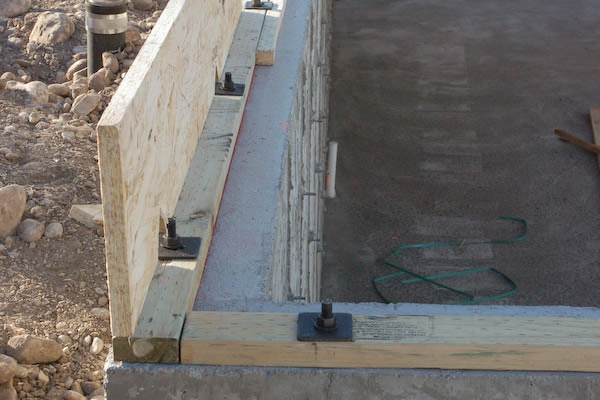
-
If there's a rim jst., don't use a 2x4 plate. Some builders, I am sure, work out a lot of this beforehand, especially if the general is also the framer. And in some other jobs such coordination may be impossible. If the bolt lands on a stud, I suppose extra studs can be added and the stud needed for attachment can be headed off at the bolt. Now some mechanically fastened bolts are approved for anchor bolts. Some innovation in technology is in order to be sure.
-
The 1/2" and 5/8" anchor bolts, washers and some standard nuts.
View models here:
3D Warehouse
3D Warehouse is a website of searchable, pre-made 3D models that works seamlessly with SketchUp.
(3dwarehouse.sketchup.com)
-
Version 1.0.7 - 03.19.2017
- Added 1/2" and 5/8" Dia. Anchor Bolt option to stemwall and slab on grade foundations.
- Anchor bolt lengths are nominal 10", 12" and 14", square washers are 2"x2" or 3"x3".
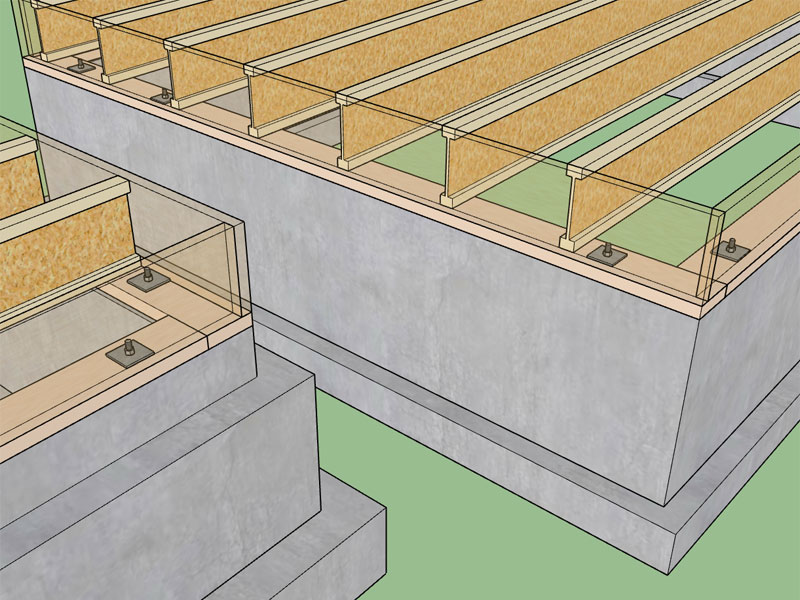
View model here:
3D Warehouse
3D Warehouse is a website of searchable, pre-made 3D models that works seamlessly with SketchUp.
(3dwarehouse.sketchup.com)
The anchor bolt, washer and nut are three separate files that are loaded in as components. Then the nut and washer components are inserted inside the bolt component and exploded so only the solid group(s) remain. Its pretty amazing what you can do with a robust API and a little bit of Ruby code.
It took me most of today to figure out how to do all of this since I'm in uncharted territory but now that I've got it kind of figured out it opens up the possibility for a host of other things (holdowns, windows, doors, vents etc...) for this plugin and the others I'm working on.
-
The cosmetic threads actually render quite nicely as does my rebar material/texture. I just realized I have not added any custom materials into the foundation plugin.
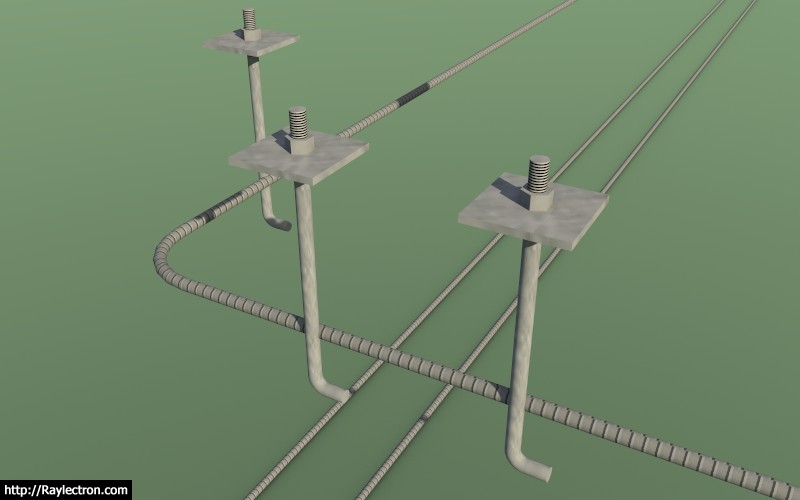
As you can see from the image the orientation of the J-bolts is the same regardless of the wall, however it would not be a couple more lines of code to orient them all facing in or facing out or some other combination. Curious how the contractors actually install these, is the orientation important?
I tried to put the 25 degree incline on the rebar grooves but there are some difficulties with extruded circular shapes and materials so the best I can do is the concentric rings as shown.
-
Orientation of J-bolts
I would think parallel to the wall to give maximum concrete cover
surrounding the J-bolt ends. -
I've been talking to a few other contractors out there and most of them don't pay alot of attention to the orientation of the J-bolts into the concrete, they let the concrete set up a bit and then stab them in.
I'm adding in the custom materials, stemwall foundation below is an example:
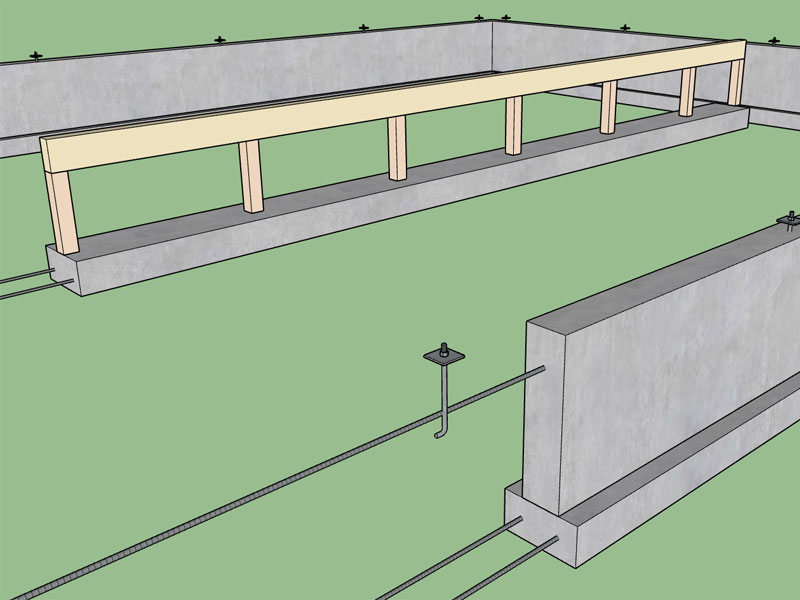
I will need to roll another revision probably tomorrow to get this update out there.
I was wondering about adding in the option for vents in the stemwall, for foundations with crawlspaces. Any thoughts on this and what is standard construction in your locale as well as what type/brand of foundation vents/inserts are used.
-
The ICC codes call out a minimum of a one vent within 3 feet of each corner. It shouldn't be to much trouble to create the openings in the stemwall and place some vents:
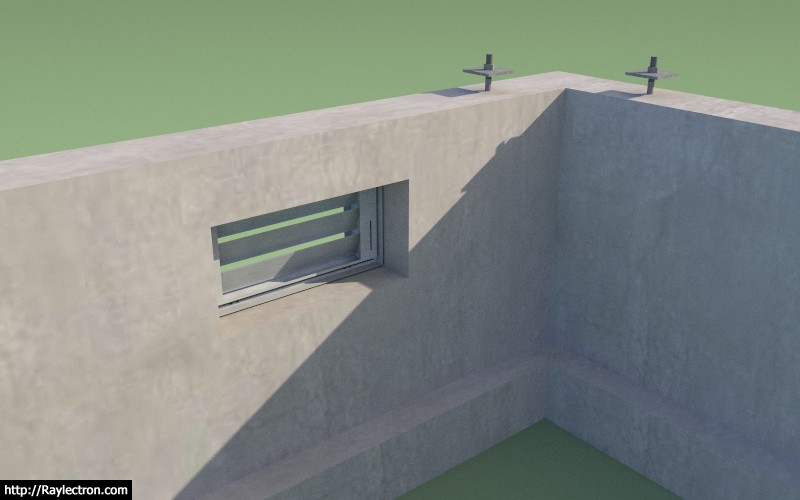
For a rectangular building (4 sides) should I place 4 vents or 8 vents? Provide only the openings or also provide a generic foundation vent (lightweight geometry?)
Moving an opening is actually very easy within SketchUp, when it comes to a solid wall like this.
What is the typical header thickness between the top of the vent hole and the top of foundation?
Vent size seems to be 16"x8" for most vents I've seen.
With regards to vents there are the cheap plastic ones you can get a Home Depot or Lowes and and then there are a whole ton of more expensive louvered metal manufacturers of vents and flood vents.
-
I've been slowly plugging away at the polygon stemwall tool, but as I was driving to work this morning I realized it would also be useful to have a simple linear or line tool as well for creating straight segments.
-
@medeek said:
What is the typical header thickness between the top of the vent hole and the top of foundation?
What I usually do is provide a solid wood header within the floor framing and suck the vents up tight to the top of the stem wall.
As to size, it will vary depending on the topography of the site, total size of the underfloor area, etc. Also, here in California if you are in the "SRA" (State Responsibility Area, which is where fire protection is provided by state forces such as Cal Fire) you have to use approved ember-resistant vents which are further limiting.
-
I've seen them dropped down and some installed at the top of the wall. I guess I will just need to add another input which allows the user to adjust the location vertically.
-
The options for the crawlspace vents (if this option enabled) will be:
1.) Width (in.)
2.) Height (in.)
3.) Corner Distance (ft.)
4.) Top Fnd. Distance (in.)
5.) Max. Spacing (ft.)
6.) Location: All Walls|Left/Right Walls|Front/Back Walls
7.) Vent Insert: NONE|PLASTIC|METALThe Max. spacing variable will determine whether to insert intermediate vents along the wall line. The module will always place two vents per wall (if wall line selected), one at each corner and then equally space vents along wall line based on the Max. spacing variable.
-
The vent module seems to be working fairly well:
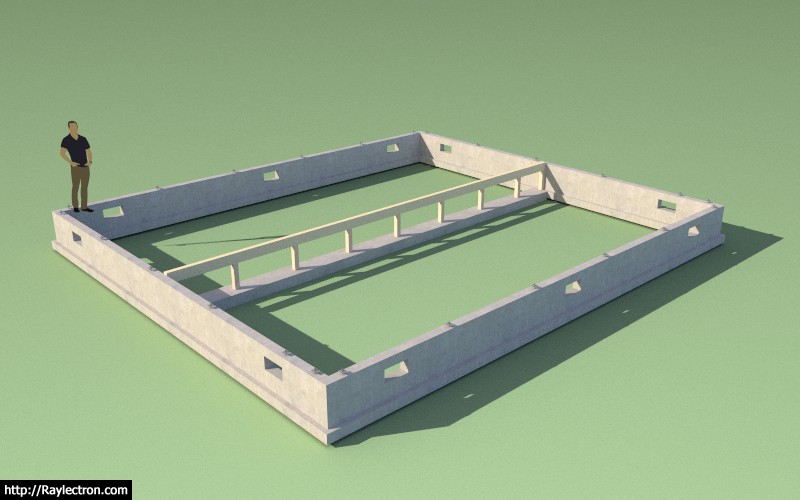
If you set the top distance to zero the vents are right up to the sill plate:

Notice the top bar is clashing with the vent cutouts.
-
Version 1.0.8 - 03.23.2017
- Added crawlspace vent option to stemwall foundations.
- Added a "Materials" tab within the global settings; Auto material assigment (colors and textures) is now an option.
- Enabled materials for all foundation types.
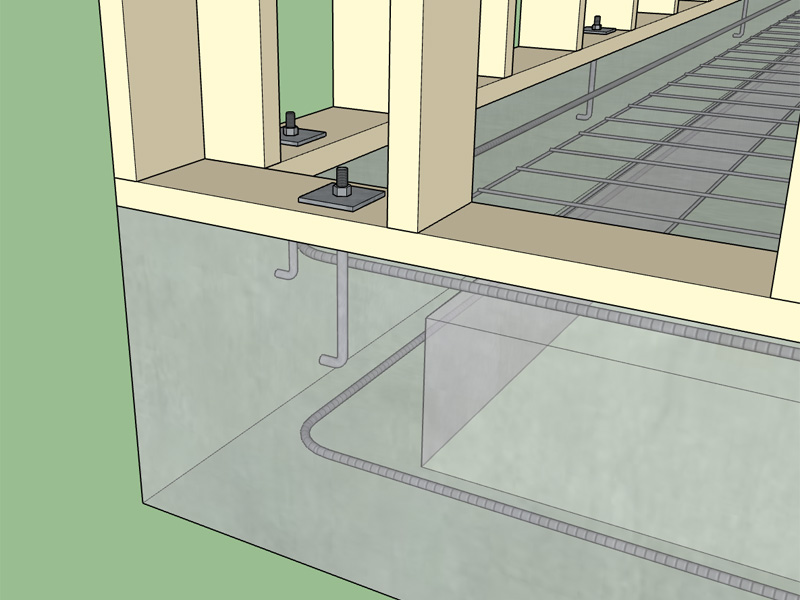
-
I have not used this extension in a while (and not on any modeling thus), updated again (as I always do when new versions come along) today from the Medeek site, version 1.0.8.
Strange, I can't seem to get any of the functions to work. The "slab" and "slab on grade" functions are probably the main reasons I got this extension and dev is standing still on "slab", licence update/renewal due within a few months, not a killer amount though but I was hoping these functions would receive some love.
Another long time problem is under settings, the "trial version" indication does not go away even when I enter my licence information.
Any ideas?
-
What is the error you are getting in the Ruby console? Please also send me your OS and SU version.
I will get to work on the slab tool next. I've been concentrating on the Truss and Wall Plugins and just got back to this one after a hiatus.
Advertisement








